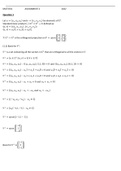Other
MAT3701 Assignment 2 2022
- Course
- Institution
MAT3701 Linear Algebra Assignment TWO of 2022 solutions. Inner product Linear operator Normal matrix Similar matrix Unitarity Unitarily equivalent Spectral decomposition Eigenvalues Eigenvectors Basis Lagrange polynomial Least squares Rigid motion Translation Reflection Rotation
[Show more]



